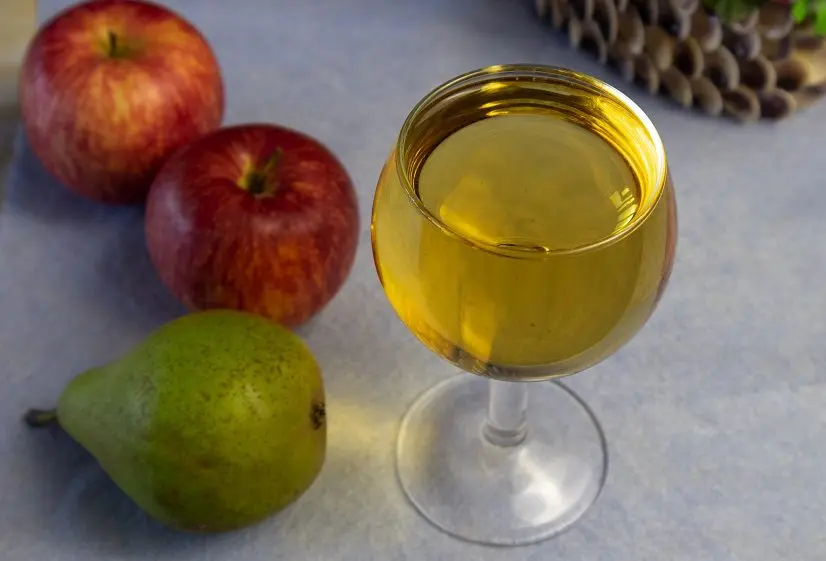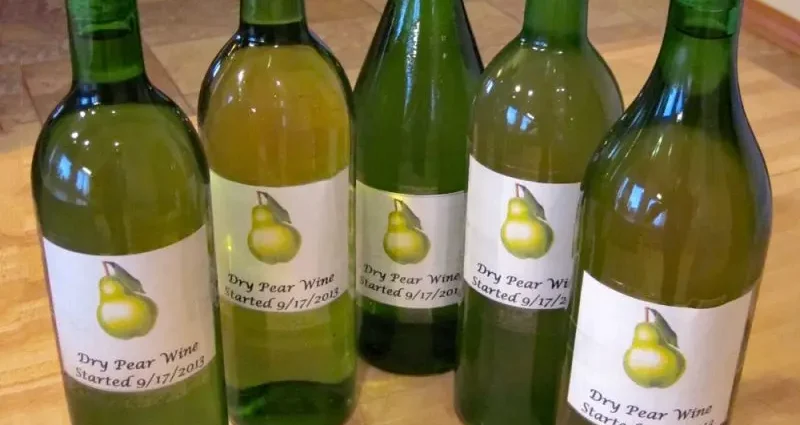In most cases, apple-pear wine is made by separate fermentation of apple and pear juice, then ready-made wine material is mixed in certain proportions before or after aging. But in this recipe, we will deviate from the classic method in order to get the original taste, which is obtained in the process of simultaneous fermentation of raw materials. Such a wine made from apples and pears has a more complex organoleptic quality than with a simple mixing of wine materials.
Theory
For the preparation of apple-pear wine, it is advisable to use fragrant pears and apples of juicy varieties with hard pulp, then you do not have to add water, the pulp will easily separate, and the wine itself will brighten well and become transparent after aging. You can take hard apples and soft pears – the taste will not suffer from this, but such a wine clarifies slowly and the color often has white shades. I do not recommend making from overripe (or soft) apples and pears at the same time.
The optimal, empirically established, proportion of apples and pears is 3:1. However, other ratios are not prohibited. It all depends on the acidity and sweetness of the raw material, it is desirable to find the optimal balance when the juice is sweet, but not cloying, with a slight sourness. There are often more apples than pears. At the same time, apples have a stronger effect on the taste of wine, and pears – on the aroma.
If the raw material is from your garden, then you can not wash it, but just wipe it with a clean, dry cloth, then wild yeast will remain on the surface, which will start fermentation. The best option is store-bought wine yeast, at home they can be replaced with sourdough from raisins or berries. For washed raw materials, yeast (only wine) or sourdough is a must.
Apples and pears must be carefully sorted out, removing blackened, rotten and moldy fruits. Even a small piece of spoiled pulp can ruin an entire batch of wine. It is advisable to sterilize the used utensils and tools with boiling water in order to kill the pathogenic microflora. You can work with wine only with well-washed hands.
The amount of sugar depends on the initial sugar content of the juice and the type of wine to be obtained. Approximately 20-22% of sugar will be processed into alcohol, and the rest will give sweetness. In this case, it is necessary to take into account the natural sugar content of apples and pears. The range for apples is 6-15%, for pears 6-14%. I recommend that you first add 120 g of sugar, and then look at the situation.
apple and pear wine recipe
Ingredients:
- apples – 6 kg;
- pears – 2 kg;
- sugar – 100-300 g per 1 liter of juice;
- wine yeast or sourdough – for 7 liters of must (optional).
Technology of preparation
1. Cut apples and pears in half, remove the core and seeds, which can give bitterness.
2. Grind the pulp with the peel with a meat grinder or blender.
3. Mix both types of raw materials in a non-metallic container with a wide neck (bucket or saucepan). Add wine yeast or sourdough.
4. Cover the container with gauze so that insects do not get inside. Transfer the future wine to a dark place with a temperature of + 18-25 ° C and leave for 3 days. Every 8-12 hours, mix the must with your hand or a wooden stick, drowning the pulp in the juice – particles of peel and pulp that have floated to the surface. If during the day foam, hissing and a sour smell appear, it means that fermentation has begun.
5. Strain the wort through 2-3 layers of gauze and squeeze the pulp to dryness (no longer needed).
6. Add 60 g of sugar per 1 liter of juice to the liquid part. Stir until the sugar is completely dissolved.
7. Pour the wort into the fermentation vessel. Fill to a maximum of 75% of the volume so that there is room for the next portions of sugar, foam and carbon dioxide that is released during fermentation.
8. Install a water seal of any design on the neck of the container. You can even use a medical glove with a pierced hole in one of the fingers.

9. Transfer the wine from apples and pears to a dark room (or cover with a thick cloth) with a stable temperature of +18-28 °C. Leave until the end of fermentation.
10. After 5 days from the date of installation of the water seal, add a second portion of sugar – 30 g per 1 liter of juice. To do this, pour 50% of the fermenting juice from the planned amount of sugar through a tube into a separate container. For example, if you want to add 150 g of sugar, then you need 75-100 ml of juice. Next, mix sugar with juice, and pour the resulting syrup back into the fermenting wort and close with a water seal.
11. After another 5 days, repeat the process by adding 30 g of sugar per 1 liter of juice according to the technology from the previous stage.
12. Depending on the yeast and temperature, the fermentation of wine from apples and pears lasts 40-50 days. The end of the process is indicated by the absence of bubbles in the water seal (a deflated glove), a layer of loose sediment at the bottom, and clarification of the wine.
Attention! If the wine ferments for more than 50 days, it must be drained from the sediment and left to ferment under a water seal at the same temperature, otherwise bitterness may appear.
13. Drain the fermented wine from the sediment (preferably through a straw). Sweeten with sugar to taste. Additionally, you can fix with alcohol or vodka in an amount of 2-15% of the volume. Fortified wine keeps better, but is tougher in taste.
14. Pour the wine into aging containers, it is advisable to fill up to the very neck so that there is no oxygen left. Close hermetically and transfer to ripening in a refrigerator or cellar with a temperature of +2-16 °C. Leave for 5-6 months to ripen. The first 2 weeks can be kept under a water seal in case of repeated fermentation.
15. When a sediment appears with a layer of 2-3 cm, filter the wine by pouring it through a tube into another container. The drink is ready when the sediment does not appear for a couple of months. Then the wine can be bottled for storage and hermetically sealed.
The shelf life of homemade wine from apples and pears is up to 5 years. Fortress – 9-14% vol.











